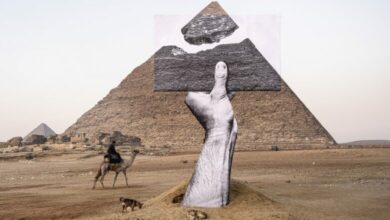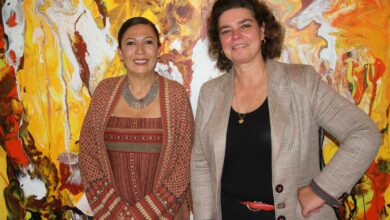– What do you do, again? Sorry, I never seem to get it right.
– I am a curator.
– You work with “Art," right?
– Yes, it's…
– Ah! I want to buy a painting!
– I am not a gallerist, but I can point out some galleries and artists to you if you like.
– Oh, that's okay… So, what exactly do you do, again?
Ten years ago I would get uncomfortable about something I couldn't fully articulate. A friend accurately diagnosed that feeling as suffering “a severe reaction towards toxically topographic exhibitions.” In other words, I cringe at the thought of having entire identities, histories, localities, individualities, nations, positions and ranges of events neatly packaged into works of art, or worse, propping up innately complex works of art, as short-hand elements in travelogue-like shows, performing cultural difference. Contemporary Arab Representations, a long-term project curated by Catherine Davide (also Curator of Documenta X), to an extent, risks being exactly that: a classic sensational one liner.
The first curatorial workshop on offer in Cairo was in 2002, marking my introduction to the enigmatic vocation of curating. I was fascinated with and unsure of what a “curator” really was. At the time, I envisioned “the curator” as follows: a woman, attractive, with the genes of a prototypical white male subject, a powerhouse that could make things happen, someone that took artists places and placed their work on a global map, both in theory and in practice, a polyglot with an endless collection of hats (both actual and symbolic), a hybrid between an artist, academic and politician that has the complete power to represent, frame, articulate facts and fictions about artists and their work (eloquently above all), and someone who generated a certain amount of commotion amongst artists who either loved her or loved to hate her all together.
Naturally, I was enthralled by this semi-mythological figure. I admit, at the time, She had only revealed herself to me as female, until I arrived at Documenta XI in Kassel, Germany, that same year. During my first encounter with the fabled quinquennial exhibition (also my first experience of any show of that size and magnitude) I couldn't help but note the scale of the show's resolution and the stature of its consequence, particularly in years to come. The platformed five-year project which re-imagined how global art could shape and destabilize an international Euro-american centralized art discourse, the show that seeded doubt at the core of the Western canon, owed its inspiring curatorial vision and artistic direction to Okwui Enwezor. Okwui is neither a woman, nor white.
I have since revered the curator figure, male or female, black or white, loved or hated. My love for this subject/position grows incrementally as I learnt that this figure had a heart, and could imbue meaning. Tracing the word to its Latin root I found that curare meant “to take care of” art, and being a curatus meant being a “spiritual guide.” Historically, a curator would “take care of” collections at a museum, manuscripts and books at libraries, and in the 16th century, curators took care of minors and lunatics. Some hundred years ago, being a curator meant being an overseer, a manager and a guardian. A decade ago, I sensed it was all that, with a tad of mystique and glamour. Today, it's still all that plus an endless scope of new responsibilities and possibilities: Curators research, write, teach, educate, facilitate, fundraise, plan, direct, produce, make and take care of artists, artist work and exhibitions from their inception as idea to long after they happen. They document, promote, present and represent past projects, all the while pitching new ones. They network, garner ideas and build publics; they work fluidly and independently, in, across, in relation to and outside institutions. They articulate concepts, brand and sell projects, and they mediate between the poles and players of the art field. They are a pendulum between practice and theory, between art and its history. Curators also fill in for critics, when the latter are absent.
In 2007, I ventured to embody this curator-function. Wanting to find my own definition of being a curator, I wanted to know how to most accurately translate this job- and subject-position into Arabic. Out of purely pragmatic reasons, rather than an ideological quest, I wanted to be able to name what I did by its name. I founded the Facebook group “Translating Curator into Arabic.” Collective and desperate measures of transliteration (and translation) failed. The fairly short-lived discussion of 32 posts ended with Alexandria-based curator Bassam al-Baroni's short recounting of the history of Egypt's modern art institutions, the pitfalls of history, language and education, pointing the discussion back to approximating the “curator” to the “commissaire d'exposition”, or “commissaire general." I could and still cannot syncretize the curator with the commissaire. Here is why: A commissaire, to me, is a man in his 40s, plainly dressed in an uninteresting grey suit, bored and power-hungry, a misogynist wearing an outrageous tie. A bureaucratic fashion victim, he is an official with the perfunctory task of making many similar exhibitions, and occasionally “toxically topographic” ones. And, worst of all, he thinks he's a curator.
At a time where the vocation seeks to be finding its momentum, I encounter art students who identify as curators, I meet commissaires who think they are curators, and galleries who want to hire curators without really knowing why. Institutions are on a constant quest to find curators, when for a decade or more they have been fine without. Truth be told, there aren't enough curators in Egypt, but neither is there an understanding of what a “curator” really is or could be. Increasingly, exhibitions are “curated,” and I am constantly told by young wary artists how it is excessive for a solo show to have a curator. A “badly curated” exhibition becomes another way of noting a shortcoming in the artist selection, a fancy way of saying a label text was poorly written, a sharp way of saying a show was badly installed. In short, the curator role, as understood, is reduced to the curator as gate-keeper, selector, finalizer or technician, without fathoming what a curator is through personal insight or historical definition.
It can be said that the rise of the curator internationally as a major player in the art field–though requiring a separate discussion all together–has a lot to do with a revised way of thinking about exhibitions and the role of the curator, since the early seventies. The vocation owes its autonomy and contemporary definition to Harald Szeeman and the Documenta V, under his curatorship in 1972, an exhibition which was received as widely controversial, as the influential Swiss-curator pioneered the group-exhibition as a 100-day event, with performances and happenings, outsider art, even non-art, repeated Joseph Beuys lectures and an installation of Claes Oldenburg's Mouse Museum, among other atypical inclusions. The exhibition also promoted the Artist's Reserved Rights Transfer and Sale Agreement, which protects artists' ongoing intellectual and financial rights with regard to production.
My remarks can be read tangentially to the artist-organized “Cairo-Documenta” exhibition recently held at the Viennoise hotel. The exhibition, a DIY initiative by young Egyptian artists, jumbles the curator and institution in a one-line disclaimer, coyly suggesting an anti-institutional turn and provoking a post-curatorial moment, which, to begin with, seems to be at odds with the absence of a working understanding of the curator-function, which still is in constant flux and definition, particularly here, where the absence of any curatorial institutionalism is quite felt. Rather than rubbing a magic lamp in hopes of Szeeman or Enwezor-inspired curators emerging on the local scene like genies, it is perhaps more grounded to demand a personalized adoption of the curator function, to nurture a type of critical thinking that shoos away the elephant from the room that is incessantly asking: So, what is it again that you do exactly?




